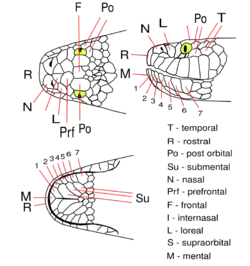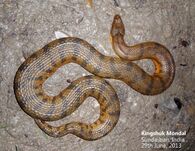Biology:Cerberus rynchops
| Cerberus rynchops | |
|---|---|

| |
| Scientific classification | |
| Domain: | Eukaryota |
| Kingdom: | Animalia |
| Phylum: | Chordata |
| Class: | Reptilia |
| Order: | Squamata |
| Suborder: | Serpentes |
| Family: | Homalopsidae |
| Genus: | Cerberus |
| Species: | C. rynchops
|
| Binomial name | |
| Cerberus rynchops (Schneider, 1799)
| |
| Synonyms[1] | |
| |
Cerberus rynchops, also known as the New Guinea bockadam, South Asian bockadam, bockadam snake, or dog-faced water snake, is a mildly venomous species of a snake in the family Homalopsidae.[2][1] It is native to coastal waters of South and Southeast Asia.[1] The species was re-delimited in 2012, allocating populations east and south of the west coast of Thailand to other species.[3]
Ecology and behaviour
It is commonly found in mangroves, mudflats, streams, ponds, tidal pools, on algae patches, and has even been found burrowing into the mud.[citation needed] It is rear-fanged and is mildly venomous.[citation needed] An aquatic and nocturnal snake, it feeds mainly on fish and is known to consume eels.[citation needed]
In captivity, it is observed to move in a sidewinding direction on land.[citation needed] In the BBC series 'Life in Cold Blood' it was filmed adapting this sidewinding technique to jump across a mudflat in Singapore; up until then, no snakes were considered able to truly jump.[citation needed] It also has a prehensile tail that would suggest it could climb mangrove trees.[citation needed] It is now known to give birth to live young, numbering from 8 to 30, either in water or on land.[citation needed]
It is a quite docile, mild-tempered and a hardy snake; in recent years it has become a welcome addition to snake hobbyists in the Philippines.[citation needed] It also owes its popularity to its bright yellow to orange belly coloring, mostly of females.[citation needed] In the Philippines, particularly in the Central Visayas area, this snake is commonly known as the "tangkig".[citation needed]
Description
The visibility of upper jaw, giving it a dog-like appearance. Head long and distinct from neck. Eyes small and beady, with rounded pupils. Dorsum dark gray, with faint dark blotches and a dark line along the sides of the head, across the eyes. Center cream with two distinct rows of large, diffuse dark gray spots.[citation needed]
Scales are distinctly keeled. Midbody scale rows 21–25. Ventrals 132–160. Subcaudals 49–72.[citation needed]
Distribution and habitat
This is a saltwater-tolerant species found in India (including Andaman and Nicobar Islands), Bangladesh, Myanmar, Thailand, and northwestern Malaysia.[1] The eastern limit of its distribution with Cerberus schneiderii is uncertain.[3]
References
- ↑ 1.0 1.1 1.2 1.3 Cerberus rynchops at the Reptarium.cz Reptile Database. Accessed 12 February 2019.
- ↑ Cite error: Invalid
<ref>tag; no text was provided for refs namediucn status 20 November 2021 - ↑ 3.0 3.1 Murphy, J.C.; Voris, H.K.; Karns, D.R. (2012). "The dog-faced water snakes, a revision of the genus Cerberus Cuvier, (Squamata, Serpentes, Homalopsidae), with the description of a new species". Zootaxa 3484: 1–34. doi:10.11646/zootaxa.3484.1.1. Abstract (pdf)
Further reading
- Boulenger GA (1890). The Fauna of British India, Including Ceylon and Burma. Reptilia and Batrachia. London: Secretary of State for India in Council. (Taylor and Francis, printers). xviii + 541 pp. ("Cerberus rhynchops [sic]", pp. 374–375).
- Karns DR, O'Bannon A, Voris HK, Weigt LA (2000). "Biogeographical implications of mitochondrial DNA variation in the Bockadam snake (Cerberus rynchops, Serpentes, Homalopsinae) in Southeast Asia". Journal of Biogeography 27: 391–402
- Schneider JG (1799). Historiae Amphibiorum naturalis et literariae. Fasciculus primus, continens Ranas, Calamitas, Bufones, Salamandras et Hydros. Jena: F. Frommann. xiii + 264 pp. + corrigenda + Plate I. (in Latin).
External links
- https://web.archive.org/web/20080823125843/http://itgmv1.fzk.de/www/itg/uetz/herp/photos/Cerberus_rynchops.jpg
- https://web.archive.org/web/20080823125753/http://itgmv1.fzk.de/www/itg/uetz/herp/photos/Cerberus_rynchops2.jpg
- https://web.archive.org/web/20080823125637/http://itgmv1.fzk.de/www/itg/uetz/herp/photos/Cerberus_rynchops3.jpg
- http://biodiversitycapiz.blogspot.co.za/2013/02/dog-faced-water-snake.html
- https://web.archive.org/web/20070109093424/http://www.wildsingapore.per.sg/discovery/factsheet/snakedogfaced.htm
- http://www.ecologyasia.com/verts/snakes/dog-faced_water-snake.htm
Wikidata ☰ Q2442553 entry
 |




